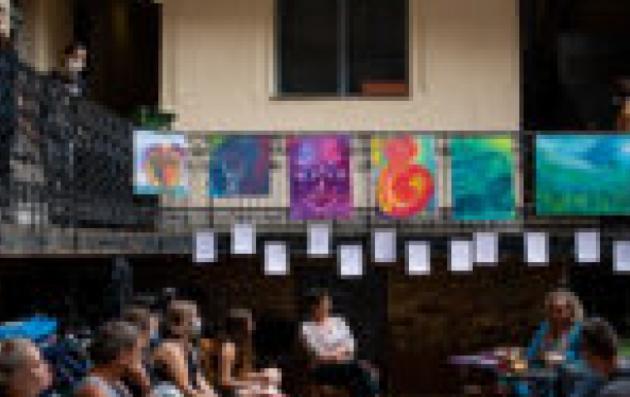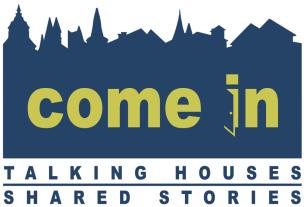Date of label : 02/06/2017
-
Budapest Ujbuda , Hungary
-
Size of city : 149.000 inhabitants
Previously transferred

Summary
People from all over Budapest (HU) take part in the city's Weekend of Open Houses – Budapest100, a festival that opens the gates of 50-60 houses and institutions each year. The event has become a tradition since its launch in 2011, with attendance reaching 20,000 visitors during the weekend.
Between 2011 and 2015 it was organised as a community-building initiative celebrating 100-year-old Budapest buildings, with the cooperation of citizens, NGOs, public institutions and district municipalities. Its main aim is to draw attention to local buildings, their architectural value and history - and to the civilian power that organises residential communities and holds them together. Since 2016, the event has been structured around a given theme or location.
The broad mission of Budapest100 is to initiate a common discussion about revival and inspire the establishment and strengthening of residential communities.
The solutions offered by the good practice
The solution offered by Budapest100 is threefold. It contributes to reforming urban community co-existence, to change the relationship between residents and the city and to help people become more responsible citizens. The weekend of open houses initiates common discussion about urban revival, underlines the values of the built environment and takes action against social isolation. Throughout Europe there are similar initiatives, but with a much lower social impact. The examples are mainly concentrating on the built environment, letting the audience enter a building and sharing with them the most important data, collected and presented by experts. Budapest100, on the other hand, adds the factors of community-building and creating value. In the apartment blocks joining the programme, residents prepare in a self-organized way (with the help of volunteers) exhibitions, cultural events, concerts and give building-history tours for the visiting audiences. The strength of the event lies in creating a demand to share and value transfer. The easiest way of social mobilisation is to create emotional engagement. The festival creates a platform for telling the stories behind closed doors and to start dialogues. Budapest100 has highlighted the possibilities of a cleverly organised, friendly city involving the residents.
Building on the sustainable and integrated approach
Through its strong community development focus, its link to informal education, social isolation and nurturing of local organisers, Budapest100 essentially includes the social aspect related to integrated urban development. Both economic and environmental aspects of urban development are tackled by the fact that residents form communities within the programme and are more alert to physical degradation. Many apartment blocks started repeating community action in a self-organising way after Budapest100, resulting in renovations and smaller architectural changes, not to mention self-organised actions. Besides mobilising internal efforts (local people caring more), Budapest100 also draws the attention of tourists, local businesses and municipalities. The real economic impact potentially achieved through these actors is significant, even if indirect. Budapest100 not only addresses the city-loving audience, but a wide range of professionals, namely architects, landscape architects and urban planners, and initiates a common discourse on the themes affecting the city and its people. During the months of the preparations for the weekend festival a significant number of volunteers are involved and trained, who get in touch with the buildings which respond to the open call. In line with the above progress of the initiative, in 2016 the festival departed from the historical aspect of celebrating 100-year-old houses (because as a consequence of WW1 there were no buildings to celebrate) and has started to be organised around a theme. In 2016 the topic was the Grand Boulevard of Budapest, in 2017 the Danube quays, in 2018 the squares of the city while in 2019 the Bauhaus heritage.
Based on a participatory approach
Budapest100 was launched by the Open Society Archives and is organised by the Hungarian Contemporary Architecture Centre, an NGO dedicated to the dissemination of architectural practices. Budapest metropolitan and district municipalities aid the organisation by financial and in-kind support (human resources, data, communication). Since the 2011 beginning, the event has been performed with a constantly growing infrastructure and press attention, with many partners joining the initiative. The festival uses already successful methods in a further developed way: recruiting a network of 150 volunteers and involving researchers. Their composition is mixed across ages and professions, including students, retired people, architects, employees of companies and artists. There is no declared hierarchical relationship among the various actors, the structure is transparent, with open communication. Residents and volunteers are realising community programmes together alongside the principles articulated by the core team of Budapest100: culture development, information transfer, preservation of values and community cooperation. Along with the programmes in the houses, workshops and discussions on urban planning also take place attracting professionals and decision-makers. The core team pays attention to the residents and makes sure they are getting involved in these discussions, so they have the opportunity to offer their own opinions and ideas.
What difference has it made?
In the past ten years, Budapest100 has opened the gates of 50 to 60 houses and institutions yearly. Based on the feedback from involved residents, the weekends were full of experiences and lessons learnt. Many of them have highlighted that they would never have thought that so many people would be interested in their lives or their neighbourhoods. In an indirect way the festival offered them the feeling of uniqueness and importance and created conditions for neighbourhoods working together towards a common goal, making the residents’ voices heard. Local communities became stronger through the access to knowledge that helps them get closer to their own stories, their buildings and through that their cities, making them feel responsible. A more concrete success is that many apartment blocks started repeating community actions in a self-organised way following Budapest100, resulting in renovations and smaller architectural changes or organising a yard picnic or concert. The festival also got international reputation: in 2013 the Guardian chose the festival as one of the most interesting programmes of the continent, and it also received one of the prizes in “The most beautiful city feast” by Lebendige Stadt Stiftung, Hamburg. Besides the URBACT good practice label Budapest100 has become a part of the Cultural Heritage in Action Programme too.
Transferring the practice
After being awarded the URBACT Good Practice title, Újbuda was able to create the Come In! Transfer Network to which six European cities (Gheorgheni RO, Forlì IT, Varaždin HR, Pori FI, Plasencia ES, Targówek/Warsaw PL) were invited. Actually, Újbuda itself also used the method of Budapest100 in another target area, Őrmező, a prefabricated housing estate. Equipped by URBACT with a toolkit, the cities could learn from each other. The transfer process was not one-sided, during the transnational meetings the existing practices of some of the transfer cities inspired Újbuda and contributed to the development of ideas to further improve the Good Practice in the following ways. 1. Organisation of spin-off activities besides the annual big festival (like the event in the Castle District of Budapest). This has partly been inspired by the Come in! project partners which transferred the good practice in neighbourhoods and not in fragmented houses through the entire city centre. 2. Reflection on modern built environment during the annual festival. It already happened that the topic of prefabricated housing estates was one among the potential topics. Most likely one of the next BP100 festivals will reflect on modern heritage. 3. Budapest100 was inspired by the Forli website as well. In Budapest there is a massive database of houses involved in the last years, but the Italian website is very professional in terms of highlighting storytelling. This was one of the key themes of the Come in! network: describing the stories of the places (in a website and on the spot) can extend the effect of the festival, making it permanent, not only one-off event. 4. Using design thinking workshop methods as a further motivation for the volunteers. 5. Moving forward from celebration to joint placemaking actions on super local level (e.g. building an inner garden in a patio).
-
271_BudapestUjbuda_Gpsummary.pdf(PDF, 45Ko)

